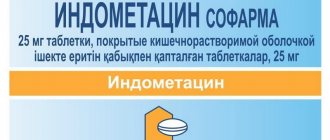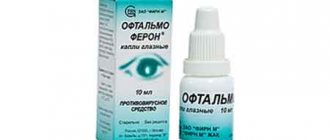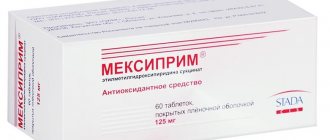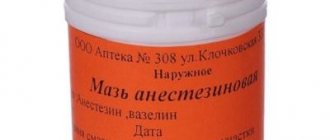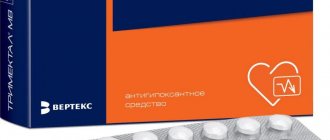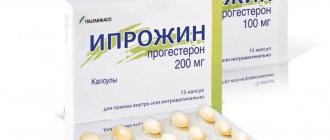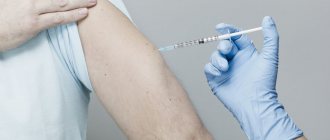Sibazon is an anxiolytic that is widely used to treat neuropsychiatric disorders, as well as a number of organic diseases of the brain. In addition, it is used in obstetric practice and as an anesthetic aid. Sibazon is an effective but unsafe drug; it has a number of strict indications, as well as contraindications for use. Sold in pharmacies with a doctor's prescription.
Pharmacodynamics and pharmacokinetics
The active substance is diazepam , belongs to the class of benzodiazepines . The drug has anticonvulsant, sedative-hypnotic, central muscle relaxant effects. The principle of action is based on stimulation of benzodiazepine receptors. The anxiolytic effect is ensured by the effect of the drug on the amygdala complex, located in the limbic system. The medication reduces the severity of feelings of fear, concern, anxiety, and emotional stress. Thanks to the effect on the nonspecific nuclei of the thalamus and the reticular formation in the brain stem, a sedative effect , and the severity of symptoms of neurotic origin (fear, anxiety) is reduced.
Inhibition of the cells of the reticular formation in the brain stem provides a hypnotic effect . Increased presynaptic inhibition causes an anticonvulsant effect. The medication suppresses the spread of epileptogenic activity without affecting the excited state of the lesion. Inhibition of polysynaptic afferent, spinal inhibitory pathways causes a muscle relaxant effect of central origin.
The drug can cause a drop in blood pressure and expand the lumen of the coronary vessels. Sibazon increases the threshold of pain sensitivity. The medication is able to suppress parasympathetic, sympathoadrenal and vestibular paroxysms. The drug reduces the production of gastric juice at night.
The effectiveness of the drug is recorded on days 2-7 of therapy. In chronic alcoholism and withdrawal syndrome, diazepam reduces the severity of negativism , tremor , agitation, hallucinations , and alcoholic delirium. In patients with arrhythmias, cardialgia , paresthesia, the therapeutic effect is observed by the end of the first week.
Pharmacological properties
The action of sibazon, like diazepam, is based on an increase in inhibitory mediators in neuronal synapses. There are two opposing systems in the brain - excitation and inhibition. With a significant predominance of the first of them, various pathological conditions arise, including anxiety disorders, epilepsy, and seizures.
Sibazone binds to benzodiazepine receptors in the brain and activates them. At the same time, the effect of gamma-aminobutyric acid on brain neurons increases. It is the main inhibitory mediator in the central nervous system. Thus, the processes of excitation are replaced by processes of inhibition and the pathological condition is stopped. The effect of sibazon comes quite quickly.
Benzodiazepine receptors are located in almost all centers of the brain, therefore inhibition is observed in all parts of the nervous system. However, it predominates in the limbic system, which is responsible for the emotional background and anxiety, as well as in foci of convulsive readiness. This allows the use of sibazon for anxiety-phobic disorders, delirium, eclampsia, and epilepsy. Sibazon also reduces the number of pain impulses coming to the brain, which is used in medical practice.
A large number of adverse reactions and contraindications are associated with the influence of sibazon on all centers of the brain, even those that are not associated with the underlying disease. Even a slight increase in inhibitory mediators in them can cause various pathological conditions.
Indications for use
Instructions for use of Sibazon are recommended to prescribe the drug for all forms of anxiety disorders.
The drug is effective for insomnia , dysphoria (combination therapy), spastic conditions (against the background of damage to the brain, spinal cord: athetosis, cerebral palsy , tetanus), spasm of skeletal muscles, rheumatic pelvispondyloarthritis, arthritis, bursitis, myositis, progressive chronic polyarthritis , vertebral syndrome, tension headache, angina pectoris.
The medication is prescribed for alcohol withdrawal syndrome: agitation, tension, anxiety, transient reactive states, tremor. For psychosomatic disorders in gynecological practice, for gestosis, status epilepticus, peptic ulcer of the digestive system, arterial hypertension, eczema, the drug is prescribed as part of complex therapy.
The drug is used for drug poisoning, Meniere's disease , as a premedication before endoscopic intervention, surgical treatment under general anesthesia.
The drug is used to relieve epileptic seizures, paranoid-hallucinatory states , motor agitation in psychiatric and neurological practice, with premature placental abruption, to facilitate labor.
Panic attack
A certain psychopathic condition characterized by specific symptoms is called an anxiety disorder. Throughout life, under certain circumstances (difficult or dangerous working conditions, various problems, etc.), every individual experiences anxiety. The appearance of such a condition indicates changes occurring not only in the body, but also in the external environment. In some cases, such an attack reaches a peak, and it can only be stopped by resorting to drug therapy. Most often, doctors recommend taking such pharmacological groups of drugs as:
- Sedatives - Corvalol, Validol.
- Adrenergic blockers - "Anaprilin".
- Tranquilizers - Sibazon, Phenazepam.
The benefits of the above remedies for anxiety disorders are as follows:
- The action occurs five to ten minutes after administration.
- With a single dose there are no adverse effects.
- Adrenergic blockers reduce sensitivity to the fear hormone, i.e. adrenaline.
- Sedatives and tranquilizers completely remove fear.
On average, an attack lasts from half an hour to an hour and a half, so you need to act quickly and use effective medications. Medicines based on medicinal plant materials have a weak sedative effect, which manifests itself after two hours. Therefore, it is not advisable to use them. They will only be beneficial if taken regularly as part of the complex treatment of such conditions.
Contraindications
Sibazon is not prescribed for diazepam intolerance, acute intoxication with other medications, acute alcohol intoxication with damage to vital organs, closed-angle glaucoma, myasthenia gravis, pregnancy, severe COPD, absence seizure, acute respiratory failure, breastfeeding.
For elderly people, with a history of epileptic seizures and epilepsy, with spinal and cerebral ataxia, with liver or kidney failure, with organic diseases of the brain, with sleep apnea , a tendency to abuse psychoactive medications, with a history of drug dependence, Sibazon is prescribed with caution .
Reviews about the drug from patients
Doctors prescribe Sibazon injections to relieve attacks in the nervous system. Based on patient reviews, you can understand how the drug works:
- Valentin, 43 years old. I used the drug to relieve severe nerve compression in the cervical region. The doctor prescribed Sibazon for osteochondrosis. When my tissues were severely pinched and there were attacks of pain, the specialist immediately gave me an intramuscular injection. The action of the drug immediately helps and relaxes tightness. I used Sibazon along with complex treatment as prescribed by the doctor;
- Irina, 27 years old. Recently, my brother was diagnosed with problems with the nervous system, which were accompanied by attacks of panic and fear. To help him, the doctor prescribed the drug Sibazon. The medicine relieves tension in the nervous system and improves the general condition of the patient. After the injection, the brother really became calm and no longer experienced inexplicable fear. The drug works well together with complex treatment;
- Margarita, 47 years old. The doctor prescribed me the drug Sibazon for the treatment of cervical radiculitis. During exacerbations, I felt severe tightness and pain. I was immediately given an injection with Sibazon and all the unpleasant symptoms went away within 15-20 minutes. The drug did not cause any side effects or complications. After the course of injections, the doctor prescribed me Sibazon tablets to maintain the therapeutic effect.
Side effects
The use of Sibazon, especially at the initial stage of treatment, can cause various adverse reactions.
Nervous system: ataxia , decreased ability to concentrate, poor coordination of movements, disorientation , dullness of emotions, fatigue, dizziness, drowsiness, slow speed of motor and mental reactions, gait instability, anterograde amnesia , euphoria , catalepsy, depressed mood, tremor of the limbs, depressive mood, weakness, confusion, euphoria, myasthenia gravis during the day, headache, paradoxical reactions, dysarthria , hyporeflexia , irritability, acute agitation, hallucinations, muscle spasms, suicidal tendencies, fear, psychomotor agitation, outbursts of aggression, insomnia, anxiety, uncontrolled body movements.
Digestive tract: decreased appetite, vomiting, nausea, dry mouth, constipation, jaundice, increased levels of liver enzymes, hypersalivation .
Hematopoietic organs: neutropenia, leukopenia, anemia, agranulocytosis , thrombocytopenia.
Cardiovascular system: with parenteral administration, a drop in blood pressure, tachycardia, and palpitations are noted.
Genitourinary system: dysmenorrhea , impaired libido, disturbances in the renal system, urinary retention.
It is possible to develop allergic reactions in the form of itching and rashes.
Description of the effect of the drug Sibazon on the fetus when treating the mother during pregnancy: suppression of the sucking reflex in newborns, disturbances in the respiratory system.
Venous thrombosis or phlebitis, swelling and redness at the injection site may develop at the injection site.
Other reactions: visual disturbances in the form of diplopia , weight loss, dysfunction of external respiration, depression of the respiratory center, bulimia, weight loss.
When the medication is abruptly discontinued or the dose is reduced, a “withdrawal” syndrome develops, which is manifested by anxiety, irritability, depression, increased sweating, depersonalization , dysphoria, sleep disturbance, nervousness, spasm of smooth muscle tissue, acute psychosis, hallucinations, convulsions, sleep disturbance, headache, hyperacusis, photophobia, paresthesia, perceptual disorder, tremor.
hypothermia , and muscle hypotension are observed in premature and full-term infants
Sibazon in pediatric practice
For young patients, the remedy is indicated for the relief of spastic conditions, as well as for diagnosed psychosomatic disorders. Initially, the child is prescribed a minimum dose, gradually increasing it to the minimum therapeutic dose. The maximum permissible daily dose for a child older than six months should not exceed 1-2.5 mg. It can be determined at the rate of 40-200 mcg per 1 kilogram of the baby’s weight. The tranquilizer in oral form is contraindicated in children under six months of age. The injection form is not administered to babies in the first month of life. According to research by neonatologists, in both full-term and premature babies, Sibazon can cause side effects such as a decrease in overall body temperature, respiratory distress and deterioration in muscle tone.
Instructions for use of Sibazon (Method and dosage)
The drug is prescribed orally, as well as intravenously, intramuscular injections of Sibazon, the instructions for use also include complex therapy with solution and tablets.
The dosage of the drug is carried out depending on the sensitivity to the drug, the clinical picture, and individual reaction.
In psychiatric practice: for phobias, states of dysphoria, hypochondriacal and hysterical reactions, neuroses, the medication is prescribed 2-3 times a day, 5-10 mg.
As an anxiolytic, diazepam is taken 2-4 times a day, 2.5-10 mg. In some cases, the amount of the drug can be increased to 60 mg per day.
In case of alcohol withdrawal syndrome, the drug is prescribed on the first day 3-4 times at a dose of 10 mg, then the amount of medication is halved.
For patients with atherosclerosis, the elderly and those with weakened immune systems, diazepam is prescribed twice a day, 2 mg.
In neurological practice, for degenerative diseases and spastic conditions of central origin, Sibazon is taken 2-3 times a day, 5-10 mg.
In rheumatology and cardiology: for arterial hypertension - 2-3 times a day, 2-5 mg, for angina - 2-3 times a day, 2-5 mg, for vertebral syndrome - 4 times a day, 10 mg.
The drug is used as part of complex therapy in the treatment of myocardial infarction: initial dosage – 10 mg intramuscularly, then 5-10 mg orally 1-3 times a day.
During defibrillation, the drug is administered as a premedication in separate doses intravenously, slowly, 10-30 mg.
For spastic conditions of rheumatic origin and for vertebral syndrome: the initial amount of the drug is 10 mg intramuscularly, then 5 mg orally 1-4 times a day.
In gynecological practice and obstetrics: for menstrual and menopausal disorders, for psychosomatic pathology, gestosis, it is recommended to take 2-5 mg of diazepam 2-3 times a day.
The initial dose for preeclampsia is 10-20 mg intravenously, followed by oral administration three times a day, 5-10 mg.
Continuous treatment is carried out for premature placental abruption until the fetus fully matures.
Premedication in surgical practice and anesthesiology: before surgery, give 10-20 mg of diazepam.
Pediatrics: for spastic conditions of central origin, for reactive and psychosomatic disorders, the amount of the drug is increased gradually.
For severe repeated epileptic seizures and status epilepticus, Sibazon is taken parenterally: for children under five years of age, slowly intravenously 0.2-0.5 mg every 2-5 minutes, maximum 5 mg.
For spinal cord injuries accompanied by hemiplegia or paraplegia, for chorea, the drug is administered intramuscularly at 10-20 mg.
For motor excitation, the drug is prescribed intravenously or intramuscularly three times a day, 10-20 mg.
To relieve muscle spasms (severe form), the drug is administered intravenously in a single dose of 10 mg.
Release form and composition
Sibazon is available in the following forms:
- tablets: biconvex, white or white with a slight yellowish tint (10 pieces in blister packs, 1, 2 or 5 packs in a cardboard pack; 20 pieces in polymer jars or glass light-protective jars, 1 jar in a cardboard pack);
- solution for intravenous and intramuscular administration: transparent, colorless or with a yellowish-green tint (2 ml in neutral glass ampoules, 5 ampoules in blister packs, 1 or 2 packs in a cardboard box; 2 ml in ampoules, in a cardboard box 10 ampoules).
Composition of 1 tablet:
- active ingredient: diazepam (sibazon) – 5 mg;
- auxiliary components: potato starch, calcium stearate monohydrate, povidone, lactose monohydrate.
Composition of 1 ml solution:
- active ingredient: diazepam (sibazon) – 5 mg;
- auxiliary components: sodium chloride, macrogol 400, propylene glycol, ethanol, water for injection.
Overdose
Taking increased doses of the drug causes decreased reflexes, paradoxical arousal , confusion, drowsiness, deep sleep, decreased response to painful stimuli, stupor, areflexia, bradycardia , tremor, impaired visual perception, depression of the respiratory and cardiovascular systems, nystagmus, collapse , to whom.
It is recommended to prescribe enterosorbents, gastric lavage, perform artificial ventilation of the lungs if necessary, and maintain blood pressure and respiratory parameters.
A specific antagonist is flumazenil , which is used exclusively in hospital settings. Flumazenil, a benzodiazepine antagonist, is not recommended for use in patients with epilepsy who are taking benzodiazepines due to the risk of provoking epileptic seizures.
Hemodialysis has not proven effective.
Reviews
Stanislav P .: “I suffer from epilepsy, for which I take Sibazon. It all started with an injection of this drug, which I was given during the first attack of seizures. Then I took it while I was undergoing examinations, but in tablets. Now that the diagnosis has been established, the doctors say that I cannot do without anticonvulsants. Sibazon helps me, I take a tablet three times a day. One of the side effects at the beginning of taking it was drowsiness, but now I’m used to it and nothing bothers me.”
Marina E .: “I have generalized anxiety disorder and several phobias. When living with this became absolutely unbearable, I turned to a psychiatrist for help. She prescribed me Sibazon tablets, but I didn’t take them for long. After the first dose, I really wanted to sleep, I took the drug for a week, and slept almost the entire week. There was no anxiety, it’s impossible to be anxious when you’re constantly sleeping, but you can’t work like that either. I stopped taking sibazon and switched to lighter medications.”
Psychiatrist : “Sibazon is a powerful benzodiazepine tranquilizer, one of the first representatives of its group of drugs. It is used by doctors of many specialties as a powerful sedative, anti-anxiety, anticonvulsant and analgesic. However, it is recommended to prescribe it exclusively in a hospital, under the supervision of a doctor. A large number of side effects, including death, require careful monitoring of the patient's condition and dosage adjustment. In some cases, sibazon is the only remedy that can cope with severe and life-threatening pathological conditions, which makes it a drug of first necessity.”
Content
Interaction
Sibazon enhances the severity of the inhibitory effect on the central nervous system of antidepressants , neuroleptics, sedatives, antipsychotic medications , muscle relaxants, drugs for general anesthesia, and narcotic analgesics.
Enhanced action and prolongation of the half-life are recorded when taken simultaneously with valproic acid , propoxyphene, propranolol , metoprolol, ketoconazole, isoniazid, fluoxetine, disulfiram, erythromycin, oral contraceptives, cimetidine and other microsomal oxidation inhibitors.
The effectiveness of the drug is reduced when taking inducers of microsomal liver enzymes. An increase in psychological dependence and increased euphoria is recorded when taking narcotic analgesics .
Antacid medications do not affect the complete absorption of diazepam, but reduce the rate of absorption. When taking antihypertensive drugs, there is an increase in the severity of the decrease in blood pressure. The simultaneous use of clozapine increases the depression of respiratory function. As a result of competition for binding to proteins, the risk of digitalis intoxication increases when using low-polarity cardiac glycosides.
In patients with parkinsonism while taking diazepam, the effectiveness of levodopa is reduced. The elimination time of the drug is prolonged when treated with omeprazole. The activity of the drug decreases with the use of psychostimulants, analeptics, and MAO inhibitors.
Sibazon can enhance the toxicity of zidovudine. Theophylline reverses and reduces the sedative effect of the drug. Rifampin reduces the concentration of the active substance, increasing its elimination.
Sibazon is incompatible with other medications, which prohibits mixing the drug with other medications in the same syringe.
Helpful information
When taking Sibazon, it is important to remember that it enhances the effect of the following drugs:
- cardiac glycosides;
- sleeping pills;
- sedatives;
- hypotensive;
- muscle relaxants;
- anesthetics;
- neuroleptics;
- analgesics;
- antidepressants;
- antiparkinsonian.
In addition, the medication is incompatible with indirect anticoagulants, irreversible MAO inhibitors, some anticonvulsants, as well as alcoholic beverages. Smoking weakens the effect of the medicine.
The risk of drug dependence is associated with taking large doses and long-term therapy, as well as in individuals who have previously consumed alcohol-containing drinks in large quantities.
The medicine is injected into the vein slowly, with the patient in a supine position. After administration, you must remain in this position for about six hours. Five percent glucose or sodium chloride is used as a solvent for intravenous infusion.
It is not allowed to abruptly stop treatment with this drug, as this is fraught with withdrawal syndrome.
During the period of treatment with Sibazon solution, care must be taken when engaging in potentially hazardous activities that require concentration and speed of psychomotor reactions, including when driving a car.
In pharmacies, this drug is dispensed only with a prescription from a physician, and not from a therapist or general practitioner, but from a neurologist.
special instructions
Intravenous infusion of diazepam is carried out slowly, preferably into a large vein at a rate of 5 mg (1 ml) per minute. Intravenous continuous infusions are unacceptable due to the risk of sediment formation and drug adsorption.
During therapy with sibazon, complete abstinence from drinking alcoholic beverages is required. In case of severe pathology of the renal and hepatic systems, regular monitoring of liver enzymes and peripheral blood patterns is required.
Long-term therapy with high doses of medication leads to drug dependence. Long-term treatment is carried out in exceptional cases. Abrupt cessation of taking the drug leads to withdrawal syndrome , which is manifested by confusion, anxiety, myalgia, headaches, tension, hyperacusis , depersonalization, derealization, tactile hypersensitivity, photophobia, epileptic seizures, hallucinations.
If during treatment the patient experiences such unusual reactions as anxiety, increased aggression, thoughts of suicide , insomnia, shallow sleep, increased muscle cramps, hallucinations, acute states of agitation, then the drug is discontinued.
In the first days of therapy, as well as with abrupt discontinuation of the drug in patients with epileptic seizures and a history of epilepsy, an acceleration in the development of seizures and status epilepticus is observed.
During pregnancy, diazepam can be prescribed only for “vital” indications, in exceptional cases. The use of Sibazon in the first trimester of pregnancy increases the likelihood of developing birth defects , and also has a pronounced toxic effect on the fetus. The use of the drug in late pregnancy leads to inhibition of the central nervous system in newborns. With constant use during pregnancy, the formation of physical dependence is observed, and sometimes “withdrawal” syndrome is recorded in newborns.
Young children are most sensitive to the depressant effects of benzodiazepines on the central nervous system. It is not recommended to prescribe drugs containing benzyl alcohol to newborns due to the risk of developing a fatal toxic syndrome, manifested by difficulty breathing, depression of the central nervous system, metabolic acidosis , drop in blood pressure, intracranial hemorrhage , epileptic seizures, and renal failure.
When diazepam is used within 15 hours before delivery in doses exceeding 30 mg, apnea, respiratory depression in newborns, hypothermia, weak sucking, drop in blood pressure, decreased muscle tone, “floppy baby” syndrome, and impaired metabolic processes in response may develop. to cold reaction .
Sibazon affects driving and performing complex work.
Not described on Wikipedia.
MNN: Diazepam.
Sibazon during pregnancy and lactation
According to the instructions, Sibazon can be prescribed to pregnant women at the end of the last trimester in case of premature birth. An anxiolytic drug is also indicated to facilitate labor and for such serious pathologies as placental abruption. In the first trimester, diazepam is contraindicated for expectant mothers, since the teratogenic effect of diazepam has been identified, as well as its negative effect on the central nervous system of the fetus. According to the instructions, Sibazon tablets should also not be taken by women during breastfeeding, since the child may develop respiratory failure and suppression of the sucking reflex.
Sibazon's analogs
Level 4 ATC code matches:
Bromazepam
Helex
Rudotel
Relium
Nozepam
Tazepam
Xanax
Elenium
Valium Roche
Alprazolam
Tofisopam
Diazepam
Grandaxin
Mezapam
Seduxen
Relanium
Lorazepam
Analogues are: Diazepam , Relanium , Relium .
Terms and conditions of storage
https://www.youtube.com/watch?v=upload
Store in a place protected from light: solution - at a temperature not exceeding 20 °C, tablets - up to 30 °C. Keep away from children.
Shelf life: tablets – 5 years; solution – 3 years.
In a place protected from light.
Keep out of the reach of children.
https://www.youtube.com/watch?v=ytaboutru
3 years.
Do not use after the expiration date stated on the package.
